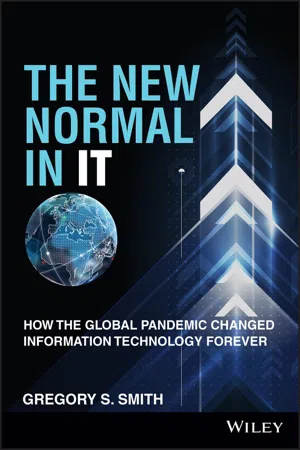
The New Normal in IT
How the Global Pandemic Changed Information Technology Forever
- English
- ePUB (mobile friendly)
- Available on iOS & Android
About this book
Learn how IT leaders are adapting to the new reality of life during and after COVID-19
COVID-19 has caused fundamental shifts in attitudes around remote and office work. And in The New Normal in IT: How the Global Pandemic Changed Information Technology Forever, internationally renowned IT executive Gregory S. Smith explains how and why companies today are shedding corporate office locations and reducing office footprints.
You'll learn about how companies realized the value of information technology and a distributed workforce and what that means for IT professionals going forward. The book offers insightful lessons regarding:
- How to best take advantage of remote collaboration and hybrid remote/office workforces
- How to implement updated risk mitigation strategies and disaster recovery planning and testing to shield your organization from worst case scenarios
- How today's CIOs and CTOs adapt their IT governance frameworks to meet new challenges, including cybersecurity risks
The New Normal in IT is an indispensable resource for IT professionals, executives, graduate technology management students, and managers in any industry. It's also a must-read for anyone interested in the impact that COVID-19 had, and continues to have, on the information technology industry.
Frequently asked questions
- Essential is ideal for learners and professionals who enjoy exploring a wide range of subjects. Access the Essential Library with 800,000+ trusted titles and best-sellers across business, personal growth, and the humanities. Includes unlimited reading time and Standard Read Aloud voice.
- Complete: Perfect for advanced learners and researchers needing full, unrestricted access. Unlock 1.4M+ books across hundreds of subjects, including academic and specialized titles. The Complete Plan also includes advanced features like Premium Read Aloud and Research Assistant.
Please note we cannot support devices running on iOS 13 and Android 7 or earlier. Learn more about using the app.
Information
PART I
The Postpandemic New Normal
CHAPTER 1
Lasting Business Impacts and Resource Sourcing After a Global Pandemic
Occurrences can be unpredictable. If we have to endure a cascade of rumpling coincidences, it's fate that dictates our lives, taking over the common procedure of “timing,” and, thus, sealing the bondage of our free choice. Once our choice is kidnapped and strangled to the core, fate checkmates our destiny.—ERIK PEVERNAGIE1
Introduction

Impacts from Covid-19 on Businesses and Organizations
- A quick recovery during which lower fatalities occur in younger people and working adults.
- A global slowdown that assumes most countries are not able to control the spread of the virus, especially in heavily populated areas, affecting small- to medium-sized companies more acutely.
- A pandemic and recession arise, assuming that the virus is not seasonal.15
Table of contents
- COVER
- TABLE OF CONTENTS
- TITLE PAGE
- COPYRIGHT
- DEDICATION
- PREFACE
- ACKNOWLEDGMENTS
- ABOUT THE AUTHOR
- PART I: The Postpandemic New Normal
- PART II: Risk Mitigation and Disaster Recovery Is Your New Friend
- PART III: IT Governance to Performance Management
- INDEX
- END USER LICENSE AGREEMENT